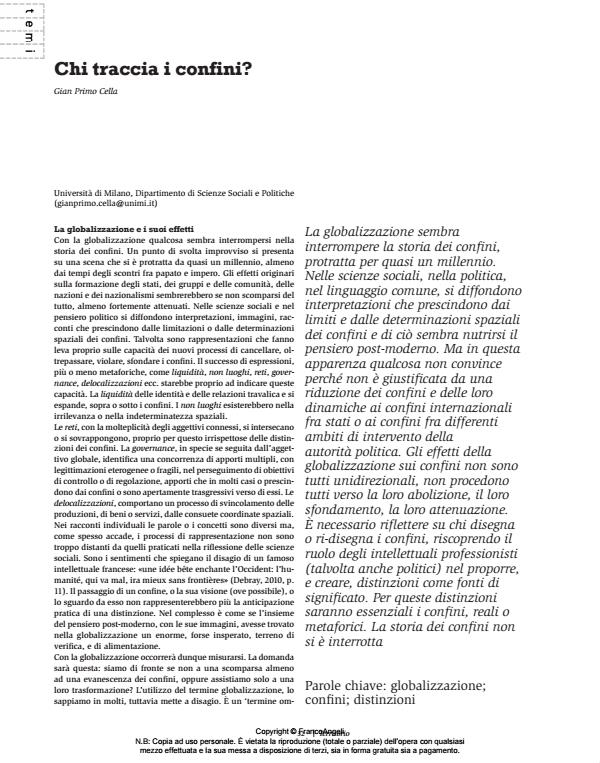Chi traccia i confini?
Titolo Rivista TERRITORIO
Autori/Curatori Gian Primo Cella
Anno di pubblicazione 2014 Fascicolo 2013/67 Lingua Italiano
Numero pagine 4 P. 32-35 Dimensione file 153 KB
DOI 10.3280/TR2013-067005
Il DOI è il codice a barre della proprietà intellettuale: per saperne di più
clicca qui
Qui sotto puoi vedere in anteprima la prima pagina di questo articolo.
Se questo articolo ti interessa, lo puoi acquistare (e scaricare in formato pdf) seguendo le facili indicazioni per acquistare il download credit. Acquista Download Credits per scaricare questo Articolo in formato PDF

FrancoAngeli è membro della Publishers International Linking Association, Inc (PILA)associazione indipendente e non profit per facilitare (attraverso i servizi tecnologici implementati da CrossRef.org) l’accesso degli studiosi ai contenuti digitali nelle pubblicazioni professionali e scientifiche
Globalisation seems to be interrupting the history of borders, which has been in progress for almost 1,000 years. Interpretations which are not based on the spatial limits and determinations of borders are spreading in social sciences, policies and everyday language, and post-modern thinking seems to gain nourishment from this. However, there is something which fails to convince in this perspective because it is not explained by a reduction in borders and in their dynamics on international borders between states and on the borders between the different areas in which political authority acts. The effects of globalisation on borders are not all in the same direction. They do not all move towards abolishing them, breaking them down and reducing them. We must think about who draws or redraws borders and rediscover the role of professional intellectuals (sometimes also politicians) in proposing and creating distinctions as sources of meaning. Borders, real or metaphorical, will be essential for these distinctions. The history of borders has not come to a halt.;
Keywords:Globalisation; borders; distinctions
- Anderson B., 1996, Comunità immaginarie, Manifestolibri, Roma (ed. or. 1983).
- Austin J.L., 1987, Come fare cose con le parole, Marietti, Genova (ed. or. 1962).
- Barth F., 1994, «I gruppi etnici e i loro confini», in Maher V. (a cura di), Questioni di etnicità, Rosenberg e Sellier, Torino, pp. 33-71.
- Benveniste E., 1976, Il vocabolario delle istituzioni indoeuropee, 2 voll., Einaudi, Torino (ed. or. 1969).
- Bourdieu P., 2001, Langage et pouvoir symbolique, Paris, Fayard.
- Cella G.P., 2006, Tracciare confini. Realtà e metafore della distinzione, Il Mulino, Bologna.
- Debray R., 2010, Ėloge des frontières, Gallimard, Paris.
- Ferrera M., 2006, The Boundaries of Welfare, Oxford U.P., Oxford.
- Held D., 2004, Global Covenant, Polity Press, Cambridge.
- Hobsbawm E.J., 1991, Nazioni e nazionalismi dal 1780, Einaudi, Torino.
- Keane J., 2003, Global Civil Society?, Cambridge U.P., Cambridge.
- Urban and Transit Planning Iacopo Zetti, Maddalena Rossi, pp.171 (ISBN:978-3-030-97045-1)
Gian Primo Cella, Chi traccia i confini? in "TERRITORIO" 67/2013, pp 32-35, DOI: 10.3280/TR2013-067005